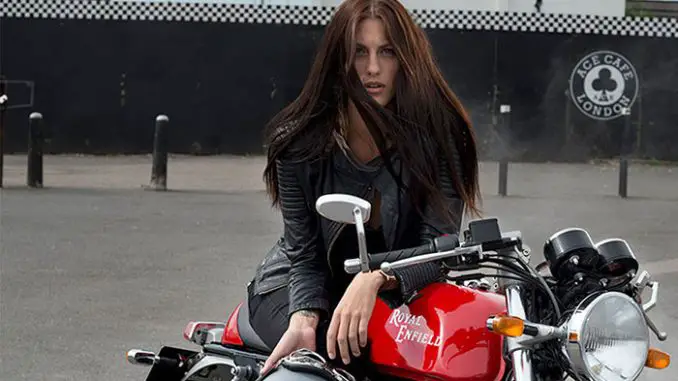
Back to 2015 Royal Enfield Motorcycle Model Review Page
Click photos to enlarge. Our big, clean bike pics make great desktop wallpaper.
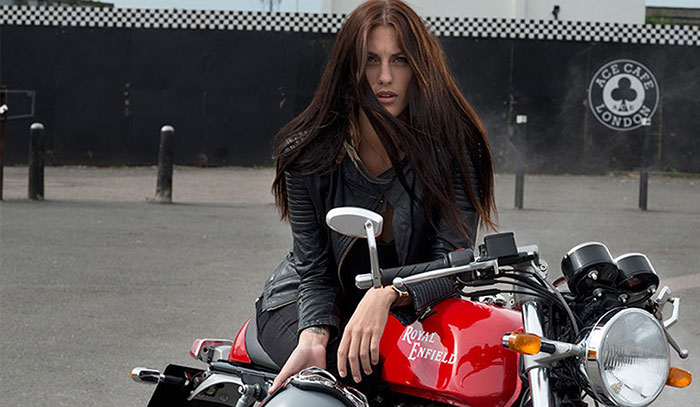
2015 Royal Enfield Continental GT Cafe Racer
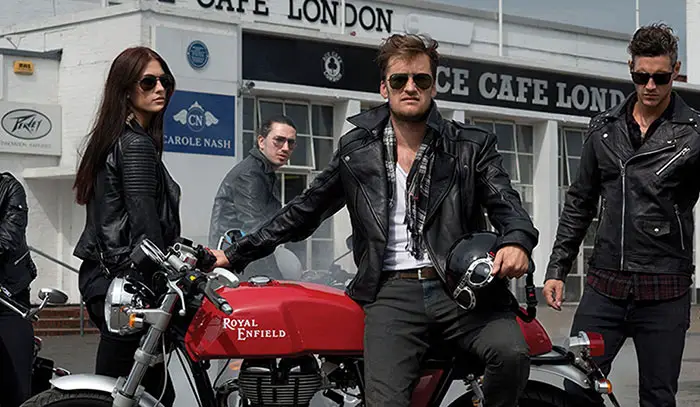
2015 Royal Enfield Continental GT Cafe Racer

2015 Royal Enfield Continental GT Cafe Racer
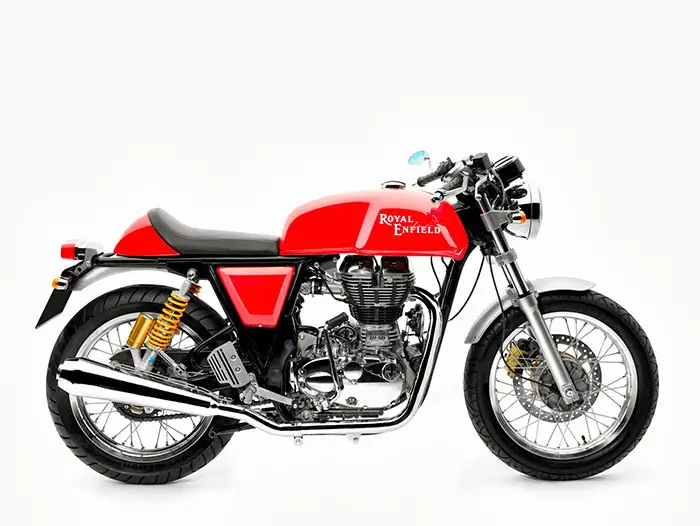
2015 Royal Enfield Continental GT Cafe Racer

2015 Royal Enfield Continental GT Cafe Racer
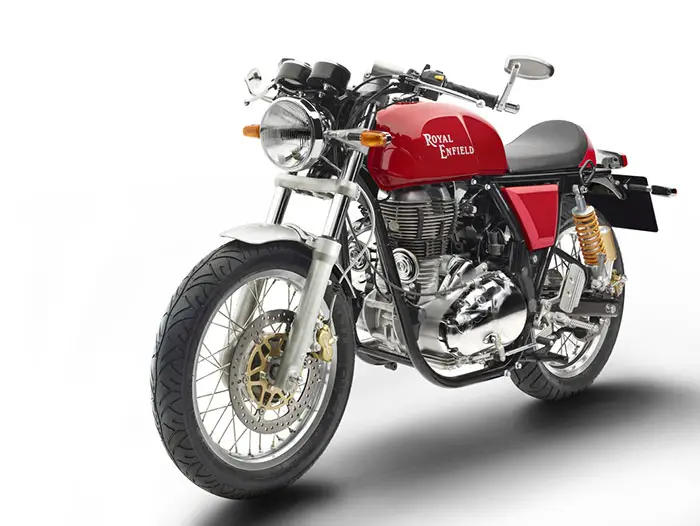
2015 Royal Enfield Continental GT Cafe Racer
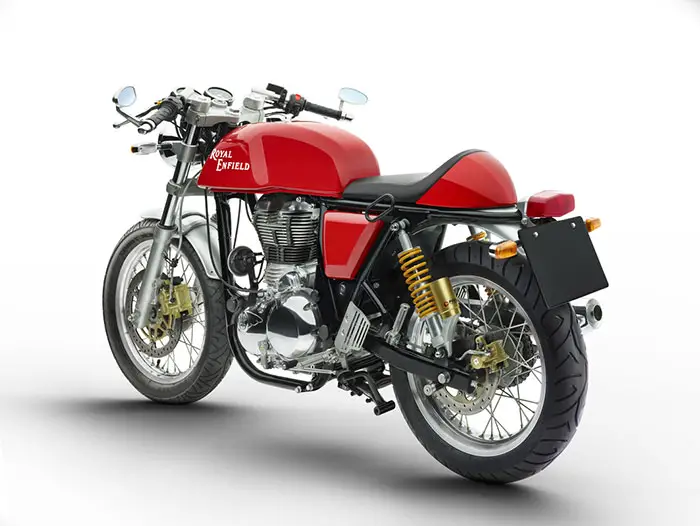
2015 Royal Enfield Continental GT Cafe Racer
2015 Royal Enfield Continental GT Cafe Racer Review
2015 Royal Enfield Continental GT Cafe Racer on Totalmotorcycle.com
Rock on…
The Royal Enfield Continental GT. This is the lightest, fastest, most powerful Royal Enfield in production.
It’s a machine with a story, a nod to motorcycling’s finest hour; a painstaking collaboration. It is also the best expression yet of a cultural phenomenon that has simply refused to fade away – the café racer.
Explore the motorcycle in its magnificence.
The standard 500cc Bullet engine has been increased to 535cc, and with a larger throttle body and hotter cam it boosts it to around 29HP. The new chassis, designed by Harris Performance, is sportier than the standard Bullet, and has a double down tube frame and longer swing arm. The suspension consists of a non-adjustable 38mm Gabriel fork and twin preload and rebound-adjustable Paioli shocks. A Brembo front brake and full-floating disc provide a serious upgrade in stopping power.
CAFÉ CULTURE
Rockers. They rode their café racers and hung out in transport “caffs”. Going on a burn-up meant riding over to the next café and back before a song finished playing on a jukebox. Getting to a 100 miles per hour during said journey was “doin’ a ton”. That said, there was a lot more to them and their way of life than just their stripped-down, souped-up motorcycles.
GT Story
A closer look into the legend behind the lightest, fastest, most powerful Royal Enfield in production Рthe Rocker culture that inspired it, the collaborators who finessed it, its combination of retro styling and ahead-of-the-curve engineering and why it is lauded by those who know their caf̩ racers. Explore the milestones in its timeline as it evolved to emerge as our finest expression yet of pure motorcycling.
1950 – 1952
the rise of the Café
Britain leaves behind ration card and gets into revival mode. Young men go back to work and start making a little extra money. To handle the needs of industrial transport, Britain’s roads get an upgrade to a network of arterial and circular roads that lead out from the center. Numerous ‘Transport Cafés’ emerge, catering to the needs of those on the move.
1956
the ace Café
The tunes of Elvis, Eddie Cochrane, Gene Vincent and other Rockabilly artists played on the jukebox of transport cafés. The Ace Café in North West London with its 24 hour service was a place the Ton up Boys frequented in large numbers; to have a cup of coffee/tea, arrange runs, listen to some music, or simply work on their bikes. Motorcycle enthusiasts in Britain took stock bikes and modified them by tinkering in their garages; they built faster machines with low slung handlebars and footrests moved further back to create a unique stance. The café racer was born and paved the way for a unique breed of motorcycles.
1959
the 59 club
In April of 1959 the 59 Club was formed strictly as a social fellowship program for unprivileged youth begun by the Eton Mission. Initiated by Eton Mission’s Curate John Oates, the 59 Club shortly became closely associated with youthful motorcyclists in an effort to provide a positive venue for rockers and a program within which to foster positive rather than anti-social values. The 59 Club is today a bastion of fond nostalgia for the wonderful days when British motorcycle technology led the world of powered two-wheeled cycling, and welcomes people who love motorcycles of any origin or nationality.
1961
birth of café racers
Royal Enfield motorcycles; namely the Meteor, and Meteor Minor get café racer treatment with rear placed foot rests and lower handlebars, thus sparking off a revolution in motorcycle styling across a variety of models. Royal Enfield becomes synonymous with sporty and nimble motorcycles, which appeals to this new breed of motorcyclists. These sporty café racer styled motorcycles gain popularity as the number of Rockers keeps increasing.
1962
the super five
The Super Five, probably the first production motorcycle with a five speed gearbox, was introduced. It featured a 9:1 compression ratio and 1’/16” inlet port, leading link forks and an old Enfield favourite, a deeply valanced front mudguard suspended from the sprung section of the forks.
1963
a glimpse at the continental gt
The Royal Enfield Continental GT makes an appearance with an Italian Style chrome petrol tank, cranked exhaust and sporty looking half exposed rear springs. The Bullet 350 also gets the same café racer treatment with rear placed foot rests and lower handlebars, keeping in tune with the new café racer styled motorcycles standard.
1964
britain’s fastest 250
To prove the new model’s capabilities, Royal Enfield got famous racers including Geoff Duke and John Cooper to ride a 24-hour sprint with five riders from John O’Groats to Land’s End. On the way they planned a stop at Oulton Park where Geoff Duke would ride several laps and also a stop off at Silverstone where John Cooper would do the same. Unfortunately due to an Iced up track, Geoff Duke never got to ride at Oulton Park, but John Cooper rode several laps at Silverstone at an average speed of 70.29mph, with a fastest lap of 73mph. Not bad for a 250cc road bike in 1964. Subsequently Royal Enfield was able to triumphantly claim the GT was “Britain’s Fastest 250”.
1965
Continental GT production commences at Redditch
Royal Enfield starts production of the Royal Enfield Continental GT out of their parent factory at Redditch. It is a 250cc four stroke motorcycle with a fiber fuel tank in a gleaming red paint finish, a 5 speed manual gear-box and an engine good for 21 Bhp of peak power.
1970
The British motorcycling industry collapses
The British Motorcycling industry faces a slowdown. Most companies have vanished into oblivion but Royal Enfield Café racers based on the Interceptor are popular amongst enthusiasts. Most noteworthy being the Metisse Frame Rickman Interceptor.
1985
The revival of café racers
Café racer culture starts reviving itself with the Bullet 350 now being exported to UK and Europe from India with the UK factory having been out of action for over 2 decades. Local dealers and experts start offering ‘Clubman’ kits to quickly convert stock motorcycles into great looking and fast moving Café racers.
1990
500cc Clubman kits
With the advent of the Bullet 500, Royal Enfield motorcycles with the ‘Clubman’ kits get a bigger heart- pushing out more power and performance.
2005
The modern cafe racer kit – Royal Enfield Electra X
The Royal Enfield Electra X powered by the Lean Burn 500cc kitted in the ‘Clubman’ guise dominates the café racer scene, with it being the only modern motorcycle available for enthusiasts.
2010
Café racer concept unveiled at the Auto Expo
The Royal Enfield café racer concept is unveiled at the 2010 Auto Expo in New Delhi, India. This generates massive curiosity amongst enthusiasts as well as the Auto media fraternity, as it marks Royal Enfield’s intention to develop a café racer motorcycle from the factory itself.
2012
Royal Enfield Continental GT showcased at the Auto Expo
The working prototype of the Royal Enfield café racer now named the ‘Continental GT’ is showcased at the 2012 Auto Expo in New Delhi.
2013
Continental GT rolls off the Oragadam assembly lines, and is launched at Ace Cafe London
Royal Enfield launches the much awaited ‘Continental GT’ with a fuel injected 535cc engine in the UK. Along with this is an exclusive range of accessories and riding gear styled on the same lines as the motorcycle. This motorcycle reinvents the café racer culture and lifestyle associated with it all over the world. The Motorcycle is Launched officially Globally in London in an alaborate sequence of events including a Burn Up run from Ace Cafe to Brighton via Brooklands.
The Dictionary of the road
rockers
Originally a British youth subculture that evolved out of the teddy boys in the 1960s; wore black leather jackets and jeans and boots; had greased hair and rode motorcycles and listened to rock’n’roll.
Café Racer
Refers to a style of motorcycle that was and is used for fast rides from one “transport café or coffee bar to another.
Ton Up
To break the 100 miles per hour barrier, preferably on a motorcycle.
Screw and Smash
1950s and early-1960s rock and roll by artists such as Gene Vincent, Eddie Cochran and Chuck Berry.
burn up
When Rockers get together and ride.
59 Club
A Church of England-based youth club founded in Hackney Wick on 2 April 1959, in the East End of London, then an underprivileged area suffering post-war deprivations. It is notable for its adoption by the British motorcycling subculture known as “rockers” in the early 1960s, its badge taking on an iconic value.
The Music
rockers
Listened to 1950s rock and roll, mostly by white American artists such as Elvis Presley, Gene Vincent, Eddie Cochran and Chuck Berry. Rockers were not only known for their attitude and fashions, but became known for their devotion to the music as much as their passion for motorcycles. Their music was regarded as ‘Screw and Smash’.
cafes
Coffee bars were attractive to the youth because in contrast to typical British pubs, which closed at about 11pm, they were open until early hours of the morning. Coffee bars and Transport Café’s also had jukeboxes, which in some cases reserved some space in the machines for the students’ own records. During that time, personal music players were few and far between; the kind of music the youth enjoyed wasn’t played on the radio, and so the jukebox was one of the few saving graces.
The hairstyle
The rocker hairstyle, kept in place with grease or hair cream, was usually a pompadour, as was popular with some 1950s rock and roll musicians. An interesting fact about the Beatles is that they initially dressed like Rockers, had their hair combed in the Rocker’s style and maintained this look while performing in Hamburg when they first began. By the time of their appearance on the Ed Sullivan Show in February, 1964 they were, however, wearing Mod suits and sporting their famous ‘mop head’ haircuts. Mods wore suits and other clean-cut outfits, parkas, and they preferred 1960s music genres such as soul, rhythm and blues, ska and beat music.
artists the rockers used to listen to:
Elvis, The King of Rock & Roll
Beatles
Stones
The Jimi Hendrix Experience
Janis Joplin
The Doors
Blind Faith
Credence Clearwater Revival
Jethro Tull
Pink Floyd
Moody Blues
Deep Purple
Jefferson Airplane
Cream
Steppenwolf
Procol Harem
The Byrds
Frank Zappa and the Mothers of Invention
record racing
‘Record Racing’ was when Rockers would play a song on the Jukebox, then have a race around a pre-determined route, and see who would reach before the song could finish. This was done especially at the Transport Café’s just outside the city, where the roads had no speed limits.
2015 Royal Enfield Continental GT Cafe Racer Totalmotorcycle.com Key Features
•Styled after iconic Cafe Racers
•Classic one-color design
•All-new, fully-integrated unit construction 535 cc engine
•Improved suspension, higher cruising speeds, and better handling
•Incredible 85 mpg fuel economy*
•Built to meet Euro III and other modern emissions standards
•Industry-leading 2 year, unlimited-mileage manufacturer warranty
* Estimate based on initial mileage reports
2015 Royal Enfield Continental GT Cafe Racer Totalmotorcycle.com Features and Benefits
The Royal Enfield Continental GT is the lightest, fastest, most powerful Royal Enfield in production. A machine with a story, a nod to motorcycling’s finest hour; a painstaking collaboration. It is also the best expression yet of a cultural phenomenon that has simply refused to fade away – the café racer.
2015 Royal Enfield Continental GT Cafe Racer – Totalmotorcycle.com North American Specifications/Technical Details
US MSRP Price: $5,990 USD
Canadian MSRP Price: $ See Dealer for pricing in CDN
Engine Single Cylinder, 4-Stroke, Spark Ignition, Air Cooled, OHV
Cubic Capacity 535 cc
Bore x Stroke 87mm x 90mm
Compression Ratio 8.5:1
Maximum Power 29.1 bhp (21.4 kW) @ 5100 rpm
Maximum Torque 44 Nm @ 4000 rpm
Ignition System Digital Electronic Ignition
Clutch Wet, Multi-Plate
Brakes- Front Brembo 300mm Floating disc, 2-Piston floating caliper
Brakes- Rear 240mm Disc, Single piston floating caliper
Tires – Front 100/90-18, 56 H Pirelli Sport Demon
Tires – Rear 130/70-18, 63 H Pirelli Sport Demon
Dimension – L x W x H 81in x 30in x 31in
Wheel Base 54 inches
Ground Clearance 5.5 inches
Weight (Wet) 412 lbs
2015 Royal Enfield Continental GT Cafe Racer – Totalmotorcycle.com European/UK Specifications/Technical Details
UK/European MSRP Price: £5,199.00 GBP (On The Road).
Engine
Type
Single Cylinder, 4 stroke, Air cooled
Displacement
535 cc
Bore x stroke
87mm x 90mm
Compression Ratio
8.5:1
Maximum Power
29.1 bhp (21.4 kW) @ 5100 rpm
Maximum Torque
44 Nm @ 4000 rpm
Ignition System
Digital Electronic Ignition
Clutch
Wet, multi-plate
Gearbox
5 Speed Constant Mesh
Lubrication
Wet sump
Engine Oil
15 W 50 API, SL Grade JASO MA
Fuel Supply
Keihin Electronic Fuel Injection
Air Cleaner
Paper Element
Engine Start
Electric & Kick
chassis & suspension
Type
Twin downtube cradle frame
Front suspension
Telescopic, 41mm forks, 110mm travel
Rear suspension
Paioli,Twin gas charged shock absorbers with adjustable preload, 80mm travel
dimensions
Wheelbase
1360 mm
Ground Clearance
140 mm
Length
2060 mm
Width
760mm ( Without Mirrors)
Height
1070mm ( Without Mirrors)
Seat Height
800 mm
Kerb Weight-(90% Fuel+Oil)
184 Kgs
Fuel Tank Capacity
13.5 Ltrs
brakes & tyres
Front Tyre
100/90-18, 56 H Pirelli Sport Demon
Rear Tyre
130/70-18, 63 H Pirelli Sport Demon
Front Brake
Brembo 300mm Floating disc, 2-Piston floating caliper
Rear Brake
240mm Disc, Single piston floating caliper
electricals
Electrical System
12 volt – DC
Battery
12 volt, 14 Ah
Head Lamp
12V H4 60 / 55 W
Tail Lamp
12V 21W/5W
Turn Signal Lamp
12V 10 W (4 Nos.)
Specifications, features and prices to change by manufacturer without notice. All information correct as of posted date.


Be the first to comment